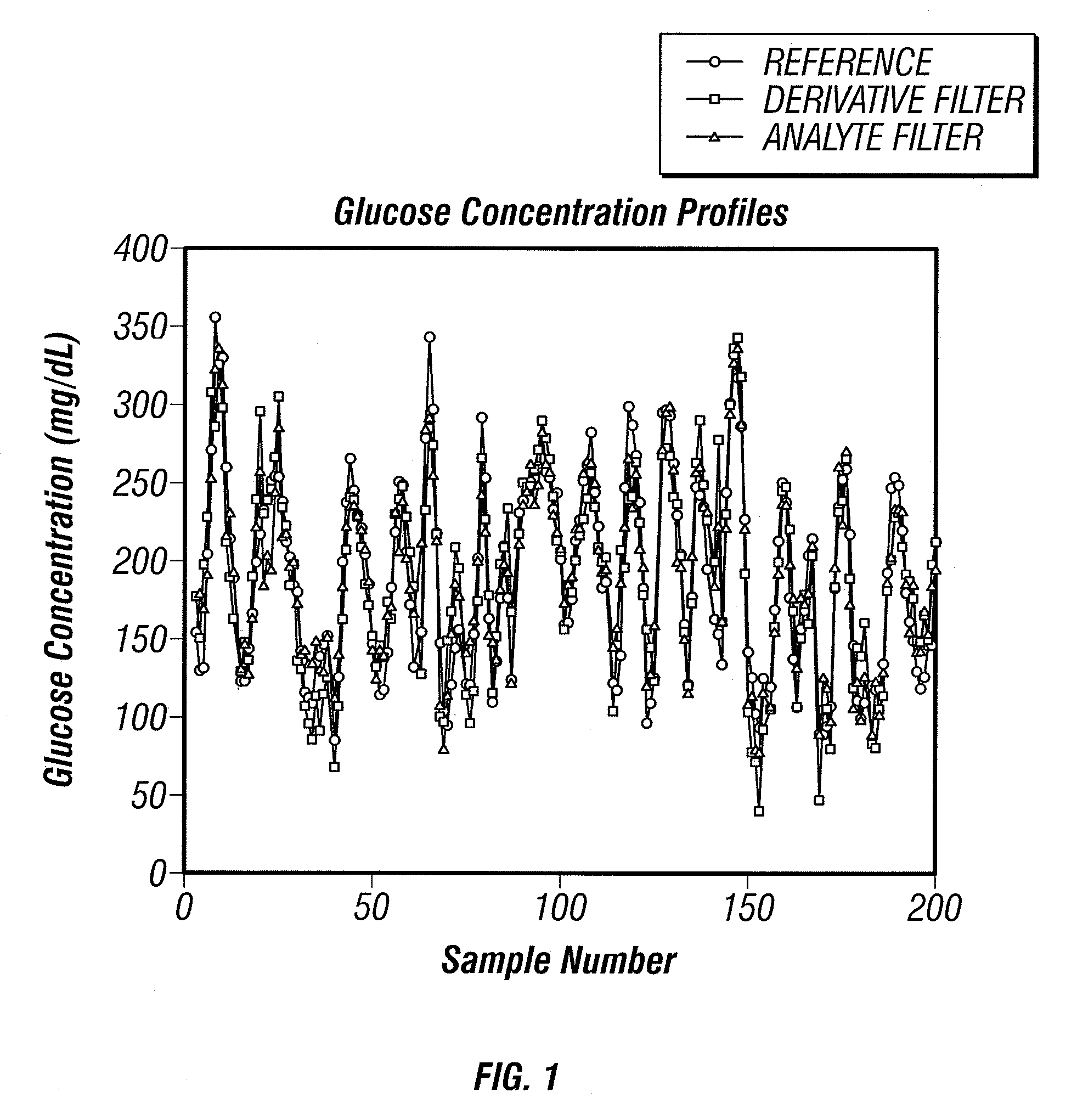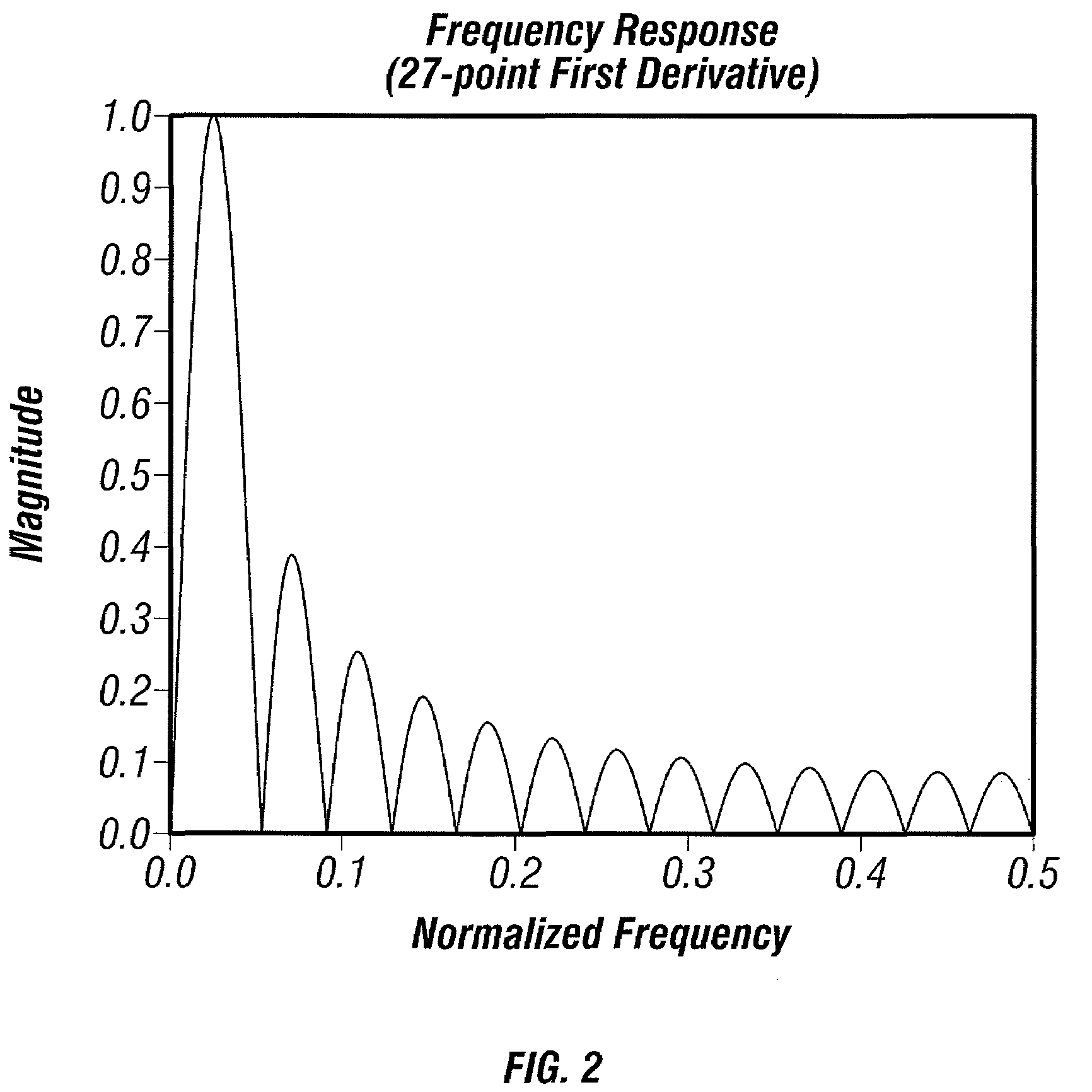Analyte filter method and apparatus
an analytical filter and filter method technology, applied in the field of biomedical methods and apparatus, can solve the problems of increasing errors, unrealistic identification performance of analytical instruments, and differences between spectrometers even of the same design, so as to enhance the analysis of non-invasive spectra and improve analytical performan
- Summary
- Abstract
- Description
- Claims
- Application Information
AI Technical Summary
Benefits of technology
Problems solved by technology
Method used
Image
Examples
example i
[0040]A data set is provided requiring multivariate analysis to derive an analyte property from a spectral data set. The data set, without modification, is processed separately first with a derivative filter and second with an analyte filter. Enhanced analyte property estimation is demonstrated with the analyte filter approach compared to the derivative filter approach demonstrating the advantage of an analyte filter over a derivative filter.
[0041]A diffuse reflectance based glucose analyzer was used to collect calibration and estimation, also referred to as prediction, near-infrared spectra. The glucose analyzer included a sample module and a base module coupled by a communication bundle. The sample module included a source, backreflector, and optics. The communication bundle carried power and optical signal. The base module included a grating and a linear photo diode array detector. Wavelength and intensity references were collected and used. In this case, the wavel...
example ii
Shape Based Design
[0077]An analyte filter is optionally created or optimized using the shape of the target analyte, preferably in conjunction with interference. The pure component spectrum of a target analyte is often considered the signal of interest in applications involving spectroscopy and noninvasive analyte property determination. The use of preprocessing techniques is traditionally aimed at enhancing and extracting the pure component analyte signal. However, the true signal of interest in multivariate applications is contained in the shape of the target analyte after orthogonalization with respect to the interference. Specifically, the net analyte signal defines that portion of the pure component analyte spectrum that is accessible for analyte measurement and is often significantly different than the pure component spectrum related to the target analyte.
[0078]Therefore, shape is the signal in the presence of interference. One measure of signal strength is the net analyte sign...
example iii
Theoretical Design
[0084]In another embodiment of the invention, a-priori knowledge of the measured system is used in the creation and / or optimization of an analyte filter. The use of a-priori knowledge for the development of an analyte filter is accomplished by selecting, parameterizing, and implementing an optimized filter using what is known about noise, interference, and the signal of interest. This method does not directly rely on a set of empirical data for the determination of the analyte filter, but instead uses theoretical methods to make a robust and optimal system for separating the spectroscopic signal from noise and interference. Optionally, a-priori knowledge is used in conjunction with, subsequent to, concurrently with, or iteratively with empirical data in analyte filter creation.
[0085]The a-prior information about random noise is in the form of one or more models, such as a statistical model, that are used to provide the corresponding frequency characteristics, N(f)....
PUM
| Property | Measurement | Unit |
|---|---|---|
| diffuse reflectances | aaaaa | aaaaa |
| diffuse reflectances | aaaaa | aaaaa |
| diffuse reflectances | aaaaa | aaaaa |
Abstract
Description
Claims
Application Information
 Login to View More
Login to View More - R&D
- Intellectual Property
- Life Sciences
- Materials
- Tech Scout
- Unparalleled Data Quality
- Higher Quality Content
- 60% Fewer Hallucinations
Browse by: Latest US Patents, China's latest patents, Technical Efficacy Thesaurus, Application Domain, Technology Topic, Popular Technical Reports.
© 2025 PatSnap. All rights reserved.Legal|Privacy policy|Modern Slavery Act Transparency Statement|Sitemap|About US| Contact US: help@patsnap.com



